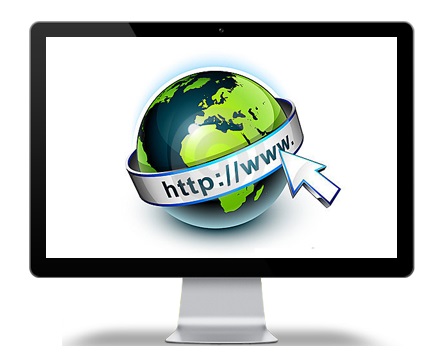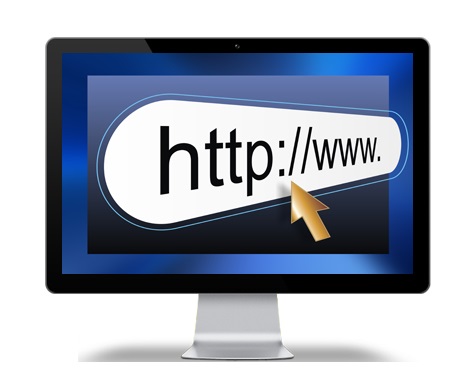About the World Wide Web:
The concept of Internet was born when people connected the computer using cables and telephone lines. They found that the easiest way to share the information stored on their computers was to form a network of computers. By adding more and more network, it became the largest group of computers. By adding more and more networks, it became the largest group of connected computers in the world.
At first, the Internet was used only by the government researchers and academics, to exchange research notes and data. But they could send the information only in the plain text format. Later, as new generation joined the network a need was felt to transmit graphics, sounds, and even movies over the Internet. Then computer companies created software’s to satisfy this increasing need and as a result the World Wide Web was born.
 The World Wide Web (WWW) was originally developed in 1990 and is currently managed by The World Wide Web Consortium. The Consortium is funded by a large number of corporate members. Its purpose is to promote the growth of the World Wide Web by developing technical specifications and reference software that will be freely available to everyone.
The World Wide Web (WWW) was originally developed in 1990 and is currently managed by The World Wide Web Consortium. The Consortium is funded by a large number of corporate members. Its purpose is to promote the growth of the World Wide Web by developing technical specifications and reference software that will be freely available to everyone.
The World Wide Web is important part of the Internet.
Through text, graphics, pictures, animation, sound and video, the Web allows rich and diverse communication. To sum up we can say that:
- The World Wide Web is a collection of electronic documents that are linked together like a spider Web.
- These documents are stored on computer called servers located around the world.
- The web has evolved into a global electronic publishing medium and medium for conducting electronic commerce.
- The World Wide Web helps us to communicate with people through e-mail, chat rooms, etc.
The World Wide Web has also become the medium of social interaction through sites like Orkut, Facebook, Bigadda, etc.
Components of World Wide Web:
The information available on World Wide Web is stored on special computers called Web servers in the form of Web pages and Webster. These servers are connected to the Internet.
Web Pages:
- A web page is an electronic document which is written in Hypertext Markup Language or HTML, a computer language.
- Web pages can contain text, graphics, video, animation, and sound, as well as interactive features, such as data entry forms.
- Each Web page has a unique address known as a URL (Uniform Resource Locator), which helps to identify its location on the web.
- Web pages usually contain Hyperlinks. Hyperlinks are text and images that give reference of the URLs of other Web pages.
Web Site:
- A Website is a web page or a collection of them that relate to a common theme, such as a person, business, organization or subject.
- The first page of a Website is called Home page. It acts like an index, indicating the content on the Website.
- To access other Web pages you can click Hyperlinks from the Home page.
Web Servers:
- The computer that stores the Web pages and Webster is called a Web server. The Web users can have the relevant information.
- It has the necessary hardware and software to understand and respond to the needs the web users.
Web browser:
- You have to load the software required on your computer. This software is called a Web browser.
- When you wish to access a web page or Website on the World Wide Web, you make a request through your Web browser’s window to a Web server containing the Web page or Website. The server sends the data to your computer, which the browser interprets and displays the page in its window.
In short, we can say that the World Wide Web consists of the following components:
- Your Personal Computer
- A connection to an Internet service provider (ISP)
- Servers to host the data
- Routers and switches to direct the flow of data
- Web browser software to access the web
How The Web Works:
The web is a client-server system. In this system your computer is the client; and the remote computers that store electronic files are the servers. The procedures of its working are below:
- Web pages are stored on Web servers located around the globe.
- Entering the URL (Uniform Resource Locator) of a Web page in the Address bar of your Web browser or clicking a Hyperlink sends a request to the server which hosts the page.
- The server sends the web page to your computer and your web browser displays it on your screen.



To move between Web pages or web page or Website there are main ways to follow:
- Type the URL of a Web page in the Address bar of your Web browser and then press the Enter key.
- Click a text hyperlink.
- Click a hyperlinked graphic image, such as a button, a photograph, or a drawing.
Understanding Web Addresses or URLs:
- The World Wide Web is a network of electronic files stored on computers all around the world. Uniform Resource Locators or URLs are used to locate these files. The information contained in a URL identifies the location of the requested resource once URL, or check on a hyperlink and a request is sent to a remote computer (Web server), to download one or more files.
- Examples of URLs are:
- https://informationq.com : The Home page for the Information Q website.
- News:rec.gardens.roses: A Newsgroup about rose gardening
Anatomy of a URL:
A URL is divided into many parts. Each part of a URL carries different meaning. Now we can learn how to interpret the various parts of a URL. Take the following example to understand this:
- https://informationq.com/category/computer/
- Here http:/ stands for Hypertext Transfer Protocol. This indicates a hypertext document or directory. Most URLs start with this.
- Stands for a page on the World Wide Web.
- com / is the domain name. It often tells you the name of a company, organization, university or institution. The last part of the domain name.com tells about the type of organization having this domain name or the country where it is located.
- informationq.com/ Together, it indicates the Web server name (including the domain name).
- Category / is directory or folder on the Web server that contains a group of related Web pages within the Website.
- Computer/ is a Web page inside the folder. (A URL may not always include the name of the Web page.)



Using Web URLs:
The URL of a Web page is entered by typing it into the Address bar of your Web browser. Most browsers allow you to store the URLs by adding them to a special list. Microsoft Explorer calls it Favourites while Netscape Navigator calls it Bookmarks. Once you add a URL to your list, you can access the web page simply by clicking on the name in your list.
http: indicates the method by which HTML files are transferred over the Web. Here are some other things to know about URLs:
- A URL usually carries no spaces.
- A URL always uses forward slashes (//).
- If URL is entered incorrectly, your browser will not be able to locate the Website or resource you want. If you get an error message or get access to the wrong Website, make sure that you type the URL correctly.
- You can find the URL behind a hyperlink just by placing your cursor over the link. The pointer will turn to the shape of a hand and the URL will appear in your browser’s status bar.
Identifying a Hyperlink:
Text hyperlinks generally appear underlined and its colour will be different from the rest of the text -typically in blue colour. Its shape will change from an arrow to that of a hand when you move your cursor over text link or over a graphic link.
When you return to a page with a link you’ve already visited, the hypertext words will often be in a different colour, indicating that you’ve already viewed the linked page or site. The web is a dynamic medium and some change always occurs in it. To encourage visitors to return to a site, some web publishers often update the page. That’s what makes browsing the web so exciting.
In order to determine whether a graphic or image is hyperlinked, move the mouse pointer over the image. The item is hyperlinked if:
- The pointer turns into the shape of a hand.
- A URL appears in the status bar at the lower left part of the Web browser window.
How Hyperlinks Works
- A text or graphic hyperlink hides a URL.
- Clicking a hyperlink passes the URL to your browser.
- Clicking different parts of a hyperlinked graphic called an Image map takes to different web pages. Hyperlinks can access media files, such as sound or video clips.
This can be explained in depth. Suppose you want to visit Hindustan Times Website. You enter the address or URL of the websites in your web browser. Your browser requests the Web page from the web server that hosts the desired site. The server sends the data over the Internet to your computer. Your web browser interprets the data and displays it on your computer screen.
The Hindustan times Website has hyperlinks to the website of its other publications. When you click on that link, you access the Web server having the Website of the other publications. The server hosting the Website of the Hindustan Times sends the Home page of the Website that is displayed by your browser in its window. This Homepage may have the hyperlinks to other page in the website as to the other websites.
Hypertext and hyperlinks that hold the Web together allow electronic files on the Web to be linked so you can jump easily between them by way of surfing or browsing. You can navigate through pages of information on the Web based on what interests you at a particular moment. This is commonly referred to as surfing or browsing the web.
Leave a Reply